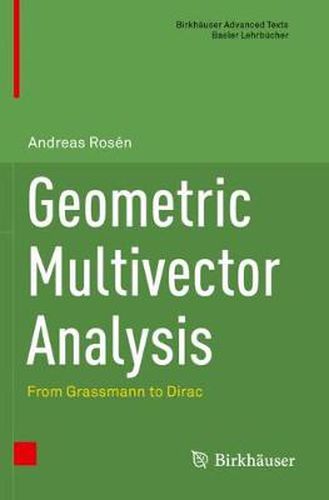Readings Newsletter
Become a Readings Member to make your shopping experience even easier.
Sign in or sign up for free!
You’re not far away from qualifying for FREE standard shipping within Australia
You’ve qualified for FREE standard shipping within Australia
The cart is loading…






This title is printed to order. This book may have been self-published. If so, we cannot guarantee the quality of the content. In the main most books will have gone through the editing process however some may not. We therefore suggest that you be aware of this before ordering this book. If in doubt check either the author or publisher’s details as we are unable to accept any returns unless they are faulty. Please contact us if you have any questions.
This book presents a step-by-step guide to the basic theory of multivectors and spinors, with a focus on conveying to the reader the geometric understanding of these abstract objects. Following in the footsteps of M. Riesz and L. Ahlfors, the book also explains how Clifford algebra offers the ideal tool for studying spacetime isometries and Moebius maps in arbitrary dimensions.
The book carefully develops the basic calculus of multivector fields and differential forms, and highlights novelties in the treatment of, e.g., pullbacks and Stokes’s theorem as compared to standard literature. It touches on recent research areas in analysis and explains how the function spaces of multivector fields are split into complementary subspaces by the natural first-order differential operators, e.g., Hodge splittings and Hardy splittings. Much of the analysis is done on bounded domains in Euclidean space, with a focus on analysis at the boundary. The book also includes a derivation of new Dirac integral equations for solving Maxwell scattering problems, which hold promise for future numerical applications. The last section presents down-to-earth proofs of index theorems for Dirac operators on compact manifolds, one of the most celebrated achievements of 20th-century mathematics.
The book is primarily intended for graduate and PhD students of mathematics. It is also recommended for more advanced undergraduate students, as well as researchers in mathematics interested in an introduction to geometric analysis.
$9.00 standard shipping within Australia
FREE standard shipping within Australia for orders over $100.00
Express & International shipping calculated at checkout
This title is printed to order. This book may have been self-published. If so, we cannot guarantee the quality of the content. In the main most books will have gone through the editing process however some may not. We therefore suggest that you be aware of this before ordering this book. If in doubt check either the author or publisher’s details as we are unable to accept any returns unless they are faulty. Please contact us if you have any questions.
This book presents a step-by-step guide to the basic theory of multivectors and spinors, with a focus on conveying to the reader the geometric understanding of these abstract objects. Following in the footsteps of M. Riesz and L. Ahlfors, the book also explains how Clifford algebra offers the ideal tool for studying spacetime isometries and Moebius maps in arbitrary dimensions.
The book carefully develops the basic calculus of multivector fields and differential forms, and highlights novelties in the treatment of, e.g., pullbacks and Stokes’s theorem as compared to standard literature. It touches on recent research areas in analysis and explains how the function spaces of multivector fields are split into complementary subspaces by the natural first-order differential operators, e.g., Hodge splittings and Hardy splittings. Much of the analysis is done on bounded domains in Euclidean space, with a focus on analysis at the boundary. The book also includes a derivation of new Dirac integral equations for solving Maxwell scattering problems, which hold promise for future numerical applications. The last section presents down-to-earth proofs of index theorems for Dirac operators on compact manifolds, one of the most celebrated achievements of 20th-century mathematics.
The book is primarily intended for graduate and PhD students of mathematics. It is also recommended for more advanced undergraduate students, as well as researchers in mathematics interested in an introduction to geometric analysis.